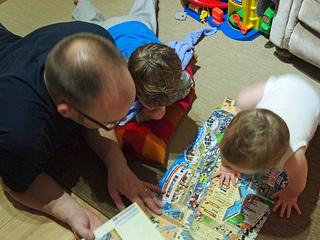 Our modern education
system, governed by tests, after-school activities, clubs, teams and
institutionalised competitiveness, leaves little room for free play. The beauty
of childhood is simply not being an adult - allowing imagination and creativity
to have free reign. These qualities are integral to a healthy adult life; basic personality traits that influence how sociable and
creative one will become.
Our modern education
system, governed by tests, after-school activities, clubs, teams and
institutionalised competitiveness, leaves little room for free play. The beauty
of childhood is simply not being an adult - allowing imagination and creativity
to have free reign. These qualities are integral to a healthy adult life; basic personality traits that influence how sociable and
creative one will become.
There are many ways to help stimulate childhood creativity and avoid relying on televisions and games consoles. Here are a few suggestions for more interactive and stimulating play:
Developmental games
Spatial and logical-based games such as jigsaw puzzles are integral to a child’s development. The importance of shape puzzles is that they allow children to develop their visualisation and learn that some shapes only fit together in certain ways. As puzzles get more difficult they learn new ways of looking at the world in general, it helps them to define objects and colours as separate entities that join to form a coherent role. The skills of rationalisation and persistence required to succeed are essential in later life.
Challenging toys
We all know how lasting a relationship children can have with their toys or dolls so it is important to choose toys wisely. Try to stay away from too many obvious media characters - often if kids know the show very well they end up revisiting storylines they have seen rather than making them up for themselves. Building sets such as Duplo and Lego are always household favourites because they encourage a degree of creativity. Likewise, arts and crafts, train sets such as Brio, and real life themed play sets such as Playmobil all demand plenty of input from the child.
Limit technological play
We have all experienced the blessed silence that comes when a kid is enjoying the wonders of technology - be that watching a favorite TV show or, increasingly, playing games on a smartphone. However, this silence is also worrying. The sheer overload of sensory stimulation requires all a child’s attention; it is much more healthy to take things bit by bit. The outdoors is a great place to experiment. Explore the senses by smelling flowers, playing in the leaves or making snowmen. Nature’s materials are Play-doh for a child’s imagination. Don’t worry about them being bored - children are incredibly resourceful when it comes to playing, they just need more free time.
Image by Julian Tysoe, used under Creative Comms license.
Thank you so much for stopping by! If you enjoyed this post, please join us on Facebook,Twitter,Pinterest and G+. Click on the buttons on the right hand side to follow us on these platforms.
